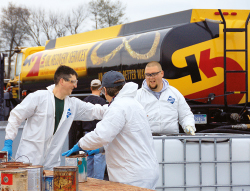Since 2004, WACKER has been using a system to assess its sites’ environmental performance. We use it to convert a site’s total emissions and energy consumption into environmental units, which take both absolute emissions and so-called weighting factors into consideration. These factors take account of four criteria:
- Environmental impact
- Safety of treatment/disposal
- Requirements imposed by environmental legislation and corporate policy
- Public acceptance
For example, we give energy consumption (power/heat consumption) a high weighting due to public awareness of the significance of greenhouse gases and international climate-protection agreements. Emissions of carbon dioxide (CO2) and other greenhouse gases are largely energy-related at WACKER.
The number of environmental units has risen due to WACKER POLYSILICON’s expansion program and its corresponding increase in electricity consumption. Nevertheless, we made significant advances in 2009/2010 based on production volumes.
| download table |
|
Environmental Units |
|
|
| |||||
|
|
20101 |
2009 |
2008 | |||||
|
|
|
|
| |||||
| ||||||||
|
Environmental units |
75,563 |
67,934 |
70,666 | |||||
|
Gross production volume in 1,000 metric tons |
12,100 |
9,111 |
7,639 | |||||
|
Environmental units per 1,000 metric tons of gross production |
6.2 |
7.5 |
9.25 | |||||

Trading hazardous waste for flowers – that was the motto for this year’s “Household Hazardous Waste Day,” held every spring for neighbors at WACKER’s Adrian, Michigan site. The event is an opportunity for neighbors from Lenawee county to bring in almost anything not allowed in trash cans, such as oil and paints, flammable liquids, waste oil, antifreeze, insect repellents, spray cans, alkaline and mercury batteries, fluorescent tubes and incandescent lamps. To thank the neighbors for bringing their hazardous waste along, WACKER gives away flowering plants. Held since 1997 and staffed by WACKER volunteers, this campaign has resulted in the collection of around 112 metric tons of hazardous waste.

